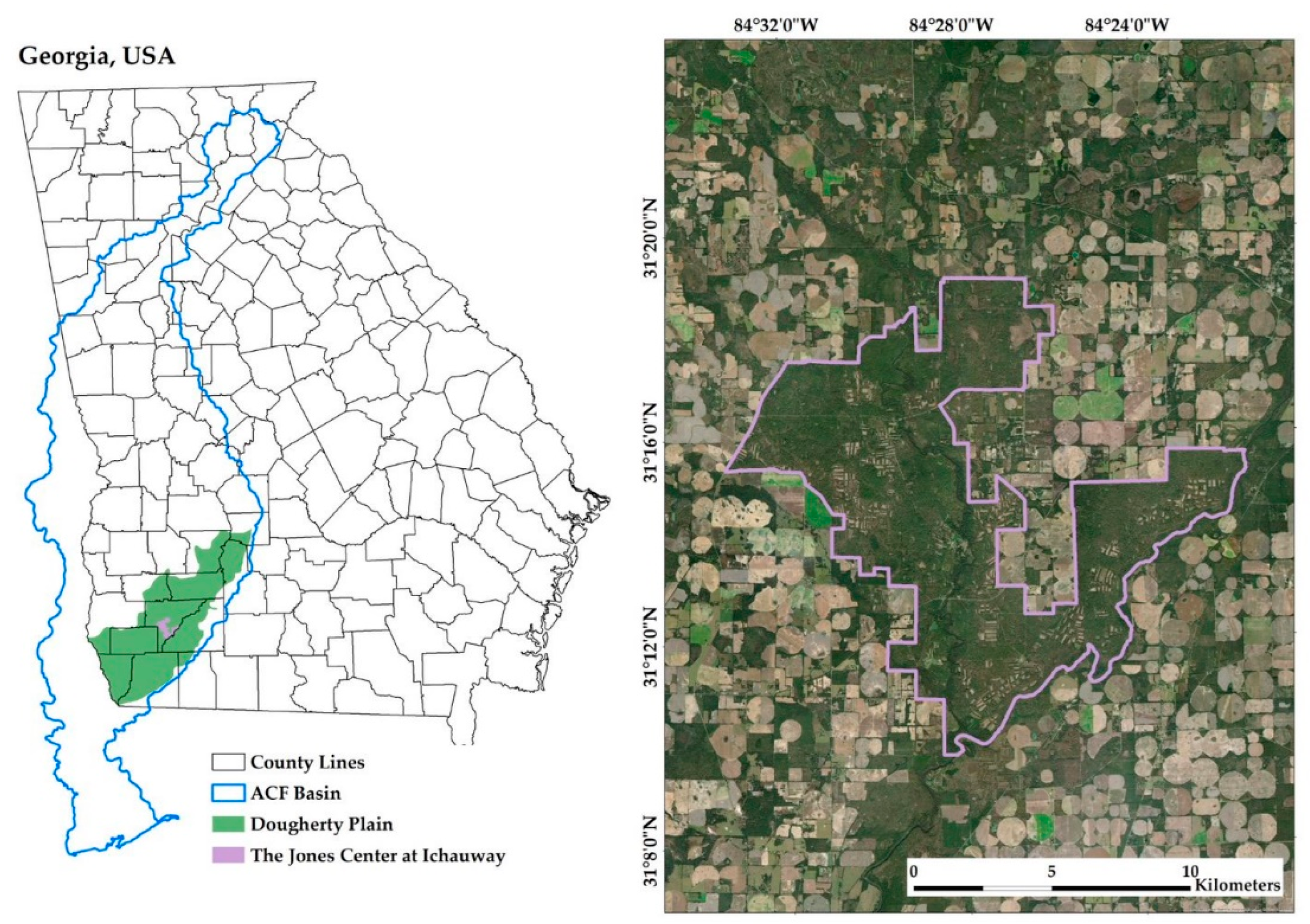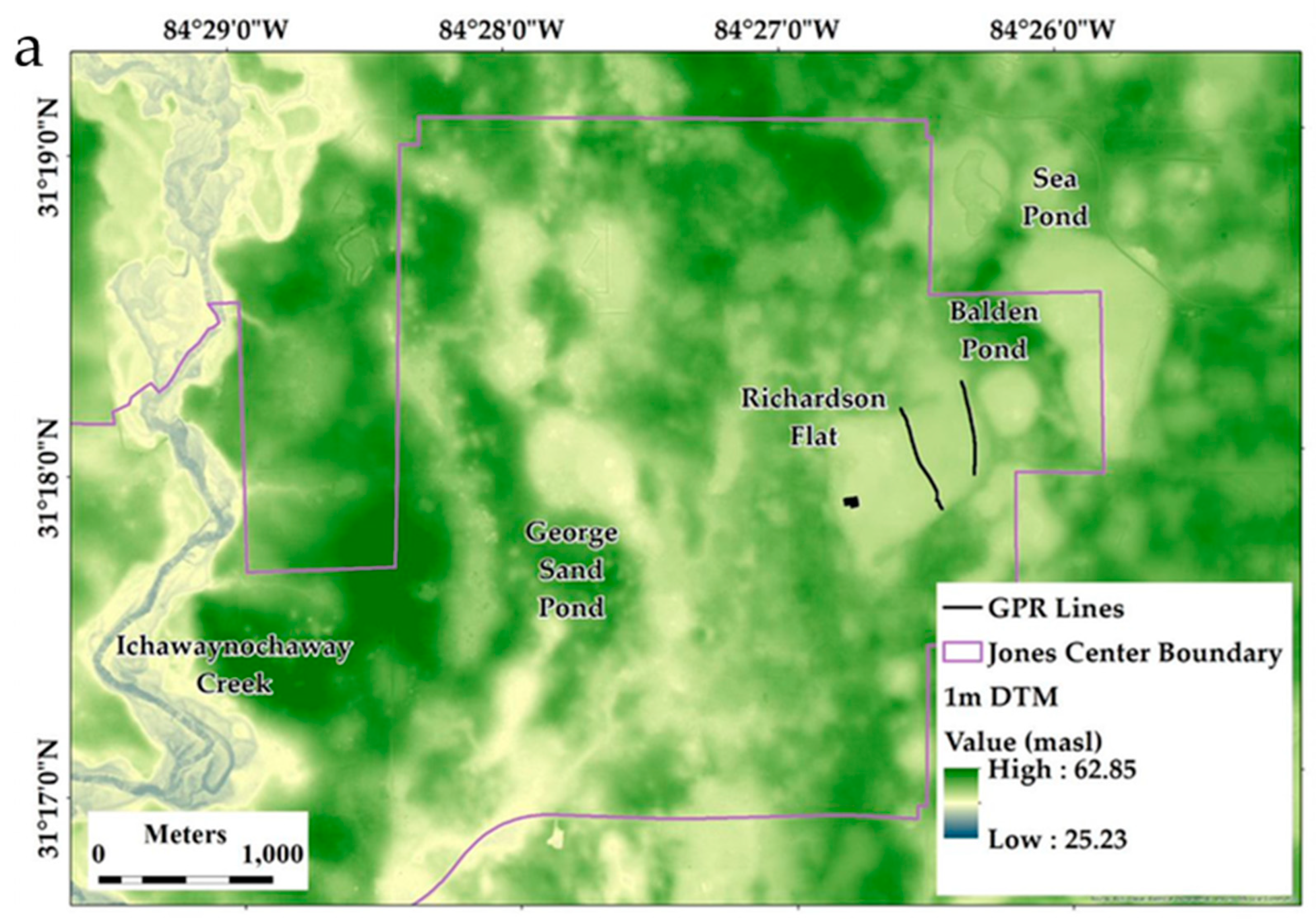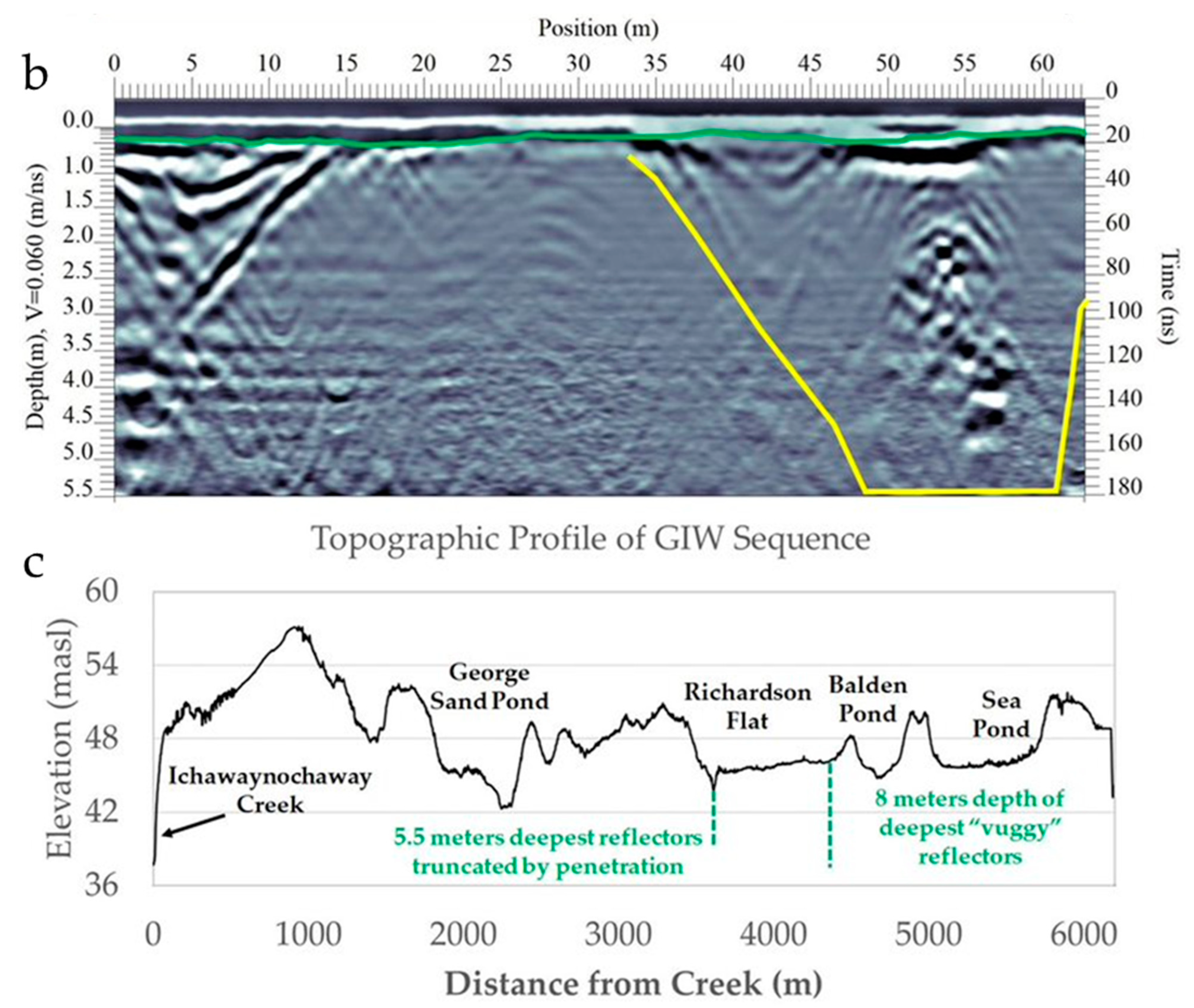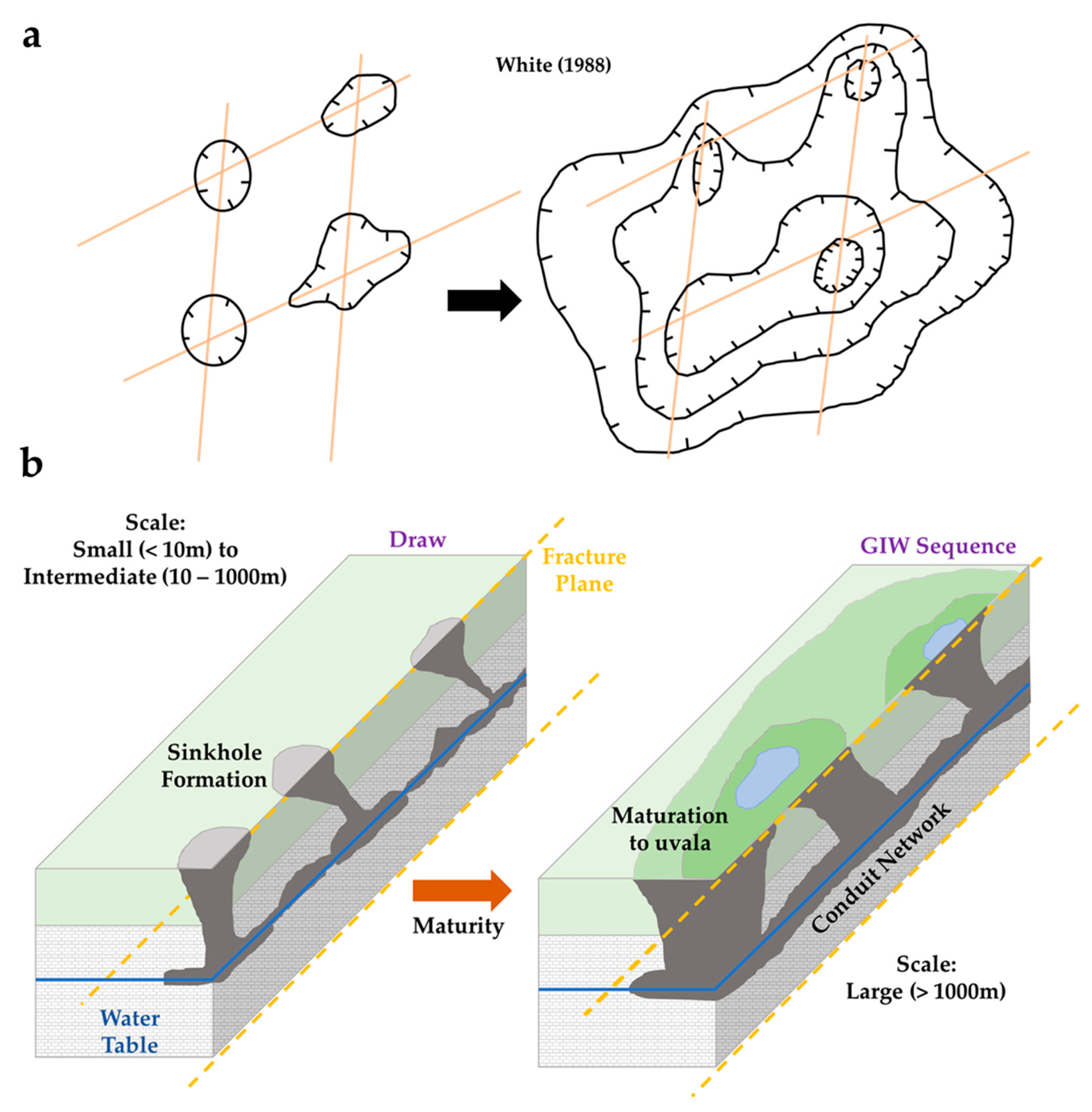Ground-Penetrating Radar Detection of Hydrologic Connectivity in a Covered Karstic Setting
Abstract
1. Introduction
2. Materials and Methods
2.1. Description of the Study Area
2.2. Data Collection
3. Results
4. Discussion
Author Contributions
Funding
Institutional Review Board Statement
Informed Consent Statement
Conflicts of Interest
References
- Fanning, J.L.; Trent, V.P. Water Use in Georgia by County for 2005, and Water-Use Trends, 1980–2005; US Department of the Interior, US Geological Survey: Atlanta, GA, USA, 2009.
- Martin, G.I.; Hepinstall-Cyerman, J.; Kirkman, L.K. Six Decades (1948–2007) of Landscape Change in the Dougherty Plain of Southwest Georgia, USA. Southeast. Geogr. 2013, 53, 28–49. [Google Scholar] [CrossRef]
- Golladay, S.W.; Gagnon, P.; Kearns, M.; Battle, J.M.; Hicks, D.W. Response of freshwater mussel assemblages (Bivalvia: Unionidae) to a record drought in the Gulf Coastal Plain of southwestern Georgia. J. N. Am. Benthol. Soc. 2004, 23, 494–506. [Google Scholar] [CrossRef]
- Battle, J.M.; Golladay, S.W. How hydrology, habitat type, and litter quality affect leaf breakdown in wetlands on the gulf coastal plain of Georgia. Wetlands 2007, 27, 251–260. [Google Scholar] [CrossRef]
- Hicks, D.W.; Golladay, S.W. Impacts of Agricultural Pumping on Selected Streams in Southwestern Georgia; Georgia Environmental Protection Division: Atlanta, GA, USA; Jones Ecological Research Center: Newton, GA, USA, 2006. [Google Scholar]
- Rugel, K.; Jackson, C.R.; Romeis, J.J.; Golladay, S.W.; Hicks, D.W.; Dowd, J.F. Effects of irrigation withdrawals on streamflows in a karst environment: Lower Flint River Basin, Georgia, USA. Hydrol. Process. 2012, 26, 523–534. [Google Scholar] [CrossRef]
- Rugel, K.; Golladay, S.W.; Jackson, C.R.; McDowell, R.J.; Dowd, J.F.; Rasmussen, T.C. Using hydrogeomorphic patterns to predict groundwater discharge in a karst basin: Lower Flint River Basin, southwestern Georgia, USA. J. Hydrol. Reg. Stud. 2019, 23, 100603. [Google Scholar] [CrossRef]
- Vellidis, G.; Tucker, M.; Perry, C.; Kvien, C.; Bednarz, C. A real-time wireless smart sensor array for scheduling irrigation. Comput. Electron. Agric. 2008, 61, 44–50. [Google Scholar] [CrossRef]
- Tetzlaff, D.; Soulsby, C.; Bacon, P.; Youngson, A.; Gibbins, C.; Malcolm, I. Connectivity between landscapes and riverscapes—A unifying theme in integrating hydrology and ecology in catchment science? Hydrol. Process. Int. J. 2007, 21, 1385–1389. [Google Scholar] [CrossRef]
- Qi, J.; Brantley, S.; Golladay, S. Simulated irrigation reduction improves low flow in streams—A case study in the Lower Flint River Basin. J. Hydrol. Reg. Stud. 2020, 28, 100665. [Google Scholar] [CrossRef]
- Torak, L.J.; Painter, J.A. Geohydrology of the Lower Apalachicola-Chattahoochee-Flint River Basin, Southwestern Georgia, Northwestern Florida, and Southeastern Alabama; USGS: Reston, VA, USA, 2006.
- GWPCC. Lower Flint-Ochlockonee: Regional Water Plan; Black & Veatch and GWPCC: Albany, GA, USA, 2017. [Google Scholar]
- Jones, L.E.; Painter, J.A.; LaFontaine, J.H.; Sepúlveda, N.; Sifuentes, D.F. Groundwater-Flow Budget for the Lower Apalachicola-Chattahoochee-Flint River Basin in Southwestern Georgia and Parts of Florida and Alabama, 2008–12; US Geological Survey: Atlanta, GA, USA, 2017.
- Tiner, R.W. Geographically isolated wetlands of the United States. Wetlands 2003, 23, 494–516. [Google Scholar] [CrossRef]
- Mushet, D.M.; Calhoun, A.J.K.; Alexander, L.C.; Cohen, M.J.; DeKeyser, E.S.; Fowler, L.; Lane, C.R.; Lang, M.W.; Rains, M.C.; Walls, S.C. Geographically Isolated Wetlands: Rethinking a Misnomer. Wetlands 2015, 35, 423–431. [Google Scholar] [CrossRef]
- Daniels, R.; Raymond, B. Part 629—Glossary of Landform and Geologic Terms; USDA NRCS: Washington, DC, USA, 2017.
- USDA. Soil Survey Manual; US Department of Agriculture: Washington, DC, USA, 1993.
- Deemy, J.B.; Rasmussen, T.C. Hydrology and water quality of isolated wetlands: Stormflow changes along two episodic flowpaths. J. Hydrol. Reg. Stud. 2017, 14, 23–36. [Google Scholar] [CrossRef]
- Hicks, D.; Gill, H.E.; Longsworth, S. Hydrogeology, Chemical Quality, and Availability of Ground Water in the Upper Floridan Aquifer, Albany Area, Georgia; Department of the Interior, US Geological Survey: Atlanta, GA, USA, 1987.
- Kruse, S. Three-dimensional GPR imaging of complex structures in covered karst terrain. In Proceedings of the 15th International Conference on Ground Penetrating Radar, Brussels, Belgium, 30 June–4 July 2014. [Google Scholar]
- Kruse, S.; Grasmueck, M.; Weiss, M.; Viggiano, D. Sinkhole structure imaging in covered karst terrain. Geophys. Res. Lett. 2006, 33. [Google Scholar] [CrossRef]
- Ford, D.C.; Williams, P.W. Karst Geomorphology and Hydrology; Springer: Berlin/Heidelberg, Germany, 1989; Volume 601. [Google Scholar]
- Palmer, A.N. Origin and morphology of limestone caves. Geol. Soc. Am. Bull. 1991, 103, 1–21. [Google Scholar] [CrossRef]
- White, W.B. Geomorphology And hydrology of Karst Terrains; Oxford University Press: New York, NY, USA, 1988. [Google Scholar]
- Beck, B.F. A generalized genetic framework for the development of sinkholes and karst in Florida, USA. Environ. Geol. Water Sci. 1986, 8, 5–18. [Google Scholar] [CrossRef]
- Brook, G.; Allison, T. Fracture mapping and ground susceptibility modeling in covered karst terrain—The example of Dougherty County, Georgia. In Proceedings of the Symposium on Land Subsidence; IAHS Publication: Venice, Italy, 1986. [Google Scholar]
- Barrie, C.J.; Rasmussen, T.C.; Tollner, E.W.; Golladay, S.W.; Brantley, S. Steady vs dynamic stream-aquifer interactions: Lower Flint River Basin, Southwest Georgia, USA. J. Hydrol. Reg. Stud. 2022, 40, 101046. [Google Scholar]
- Martin, G.I.; Kirkman, L.K.; Hepinstall-Cymerman, J. Mapping geographically isolated wetlands in the Dougherty Plain, Georgia, USA. Wetlands 2012, 32, 149–160. [Google Scholar] [CrossRef]
- Beck, B.F.; Arden, D.D.; Institute, F.S.R. Karst Hydrogeology and Geomorphology of the Dougherty Plain, Southwest Georgia; Southeastern Geological Society: Tallahassee, FL, USA, 1984. [Google Scholar]
- Miller, J.A. Ground Water Atlas of the United States: Segment 6, Alabama, Florida, Georgia, South Carolina; US Geological Survey: Atlanta, GA, USA, 1990.
- Rugel, K.; Golladay, S.; Jacksonc, C.; Rasmussen, T. Delineating groundwater/surface water interaction in a karst watershed: Lower Flint River Basin, southwestern Georgia, USA. J.Hydrol. Reg.Stud. 2016, 5, 1–19. [Google Scholar] [CrossRef]
- Cohen, M.J.; Creed, I.F.; Alexander, L.; Basu, N.B.; Calhoun, A.J.; Craft, C.; D’Amico, E.; DeKeyser, E.; Fowler, L.; Golden, H.E. Do geographically isolated wetlands influence landscape functions? Proc. Natl. Acad. Sci. USA 2016, 113, 1978–1986. [Google Scholar] [CrossRef]
- National Ecological Observatory Network. Elevation—LiDAR (DP3.30024.001). 2022. Available online: https://data.neonscience.org/data-products/DP3.30024.001/RELEASE-2022 (accessed on 30 January 2022).
- Samouëlian, A.; Cousin, I.; Tabbagh, A.; Bruand, A.; Richarde, G. Electrical resistivity survey in soil science: A review. Soil Tillage Res. 2005, 83, 173–193. [Google Scholar] [CrossRef]
- Carpenter, P.; Ekberg, D. Identification of buried sinkholes, fractures and soil pipes using ground-penetrating radar and 2D electrical resistivity tomography. In Proceedings of the 2006 Highway Geophysics-NDE Conference, Saint Louis, MI, USA, 4–7 December 2006; pp. 437–449. [Google Scholar]
- Chalikakis, K.; Plagnes, V.; Guerin, R.; Valois, R.; Bosch, F.P. Contribution of geophysical methods to karst-system exploration: An overview. Hydrogeol. J. 2011, 19, 1169–1180. [Google Scholar] [CrossRef]
- Doolittle, A.J.; Collins, M.E. A comparison of EM induction and GPR methods in areas of karst. Geoderma 1998, 85, 83–102. [Google Scholar] [CrossRef]
- Evans, M.W.; Snyder, S.W.; Hine, A.C. High-Resolution Seismic Expression of Karst Evolution within the Upper Floridan Aquifer System: Crooked Lake, Polk County, Florida. J. Sediment. Res. 1994, 64, 232–244. [Google Scholar]
- Rodriguez, V.; Gutierrez, F.; Green, A.G.; Carbonel, D.; Horstmeyer, H.; Schmelzbach, C. Characterizing Sagging and Collapse Sinkholes in a Mantled Karst by Means of Ground Penetrating Radar (GPR). Environ. Eng. Geosci. 2014, 20, 109–132. [Google Scholar] [CrossRef]
- Vadillo, I.; Benavente, J.; Neukum, C.; Grützner, C.; Carrasco, F.; Azzam, R.; Liñán, C.; Reicherter, K. Surface geophysics and borehole inspection as an aid to characterizing karst voids and vadose ventilation patterns (Nerja research site, S. Spain). J. Appl. Geophys. 2012, 82, 153–162. [Google Scholar] [CrossRef]
- Van Schoor, M. Detection of sinkholes using 2D electrical resistivity imaging. J. Appl. Geophys. 2002, 50, 393–399. [Google Scholar] [CrossRef]
- Davis, J.L.; Annan, A.P. Ground-penetrating radar for high-resolution mapping of soil and rock stratigraphy. Geophys. Prospect. 1989, 37, 531–551. [Google Scholar] [CrossRef]
- Yilmaz, Ö. Seismic Data Analysis: Processing, Inversion, and Interpretation of Seismic Data; Society of Exploration Geophysicists: Tulsa, OK, USA, 2001. [Google Scholar]
- Toth, J. A theoretical analysis of groundwater flow in small drainage basins. J. Geophys. Res. 1963, 68, 4795–4812. [Google Scholar] [CrossRef]
- Freeze, R.; Cherry, J. Groundwater; Prentice-Hall: Englewood Cliffs, NJ, USA, 1979. [Google Scholar]








Publisher’s Note: MDPI stays neutral with regard to jurisdictional claims in published maps and institutional affiliations. |
© 2022 by the authors. Licensee MDPI, Basel, Switzerland. This article is an open access article distributed under the terms and conditions of the Creative Commons Attribution (CC BY) license (https://creativecommons.org/licenses/by/4.0/).
Share and Cite
Honings, J.P.; Wicks, C.M.; Brantley, S.T. Ground-Penetrating Radar Detection of Hydrologic Connectivity in a Covered Karstic Setting. Hydrology 2022, 9, 168. https://doi.org/10.3390/hydrology9100168
Honings JP, Wicks CM, Brantley ST. Ground-Penetrating Radar Detection of Hydrologic Connectivity in a Covered Karstic Setting. Hydrology. 2022; 9(10):168. https://doi.org/10.3390/hydrology9100168
Chicago/Turabian StyleHonings, Joseph P., Carol M. Wicks, and Steven T. Brantley. 2022. "Ground-Penetrating Radar Detection of Hydrologic Connectivity in a Covered Karstic Setting" Hydrology 9, no. 10: 168. https://doi.org/10.3390/hydrology9100168
APA StyleHonings, J. P., Wicks, C. M., & Brantley, S. T. (2022). Ground-Penetrating Radar Detection of Hydrologic Connectivity in a Covered Karstic Setting. Hydrology, 9(10), 168. https://doi.org/10.3390/hydrology9100168





